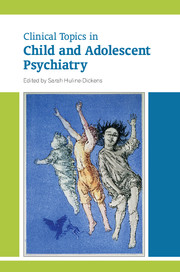Book contents
- Frontmatter
- Contents
- List of tables
- List of boxes
- List of figures
- List of contributors
- Preface
- 1 Child psychiatry and the people who have shaped it
- 2 Fabrication and induction of illness in children
- 3 Personality disorders as disorganisation of attachment and affect regulation
- 4 Post-traumatic stress disorder and attachment: possible links with borderline personality disorder
- 5 Management of antisocial behaviour in childhood
- 6 Pharmacology for attention-deficit hyperactivity disorder, Tourette syndrome and autism spectrum disorder
- 7 Pharmacology for anxiety and obsessive–compulsive disorders, affective disorders and schizophrenia
- 8 Pharmacological management of core and comorbid symptoms in autism spectrum disorder
- 9 Pharmacological treatment of depression and bipolar disorder
- 10 Cognitive–behavioural therapy with children, young people and families: from individual to systemic therapy
- 11 Anxiety disorders
- 12 Somatising: clinical presentations and aetiological factors
- 13 Somatising: management and outcomes
- 14 Evaluating psychological treatments for children with autism
- 15 Attention-deficit hyperactivity disorder: assessment and treatment
- 16 Schizophrenia
- 17 Tourette syndrome
- 18 Sleep disorders
- 19 Self-harm in adolescents
- 20 Adolescent substance misuse: an update on behaviours and treatments
- 21 Eating disorders
- 22 Gender dysphoria in young people
- 23 The psychiatry of children aged 0–4
- Index
1 - Child psychiatry and the people who have shaped it
Published online by Cambridge University Press: 02 January 2018
- Frontmatter
- Contents
- List of tables
- List of boxes
- List of figures
- List of contributors
- Preface
- 1 Child psychiatry and the people who have shaped it
- 2 Fabrication and induction of illness in children
- 3 Personality disorders as disorganisation of attachment and affect regulation
- 4 Post-traumatic stress disorder and attachment: possible links with borderline personality disorder
- 5 Management of antisocial behaviour in childhood
- 6 Pharmacology for attention-deficit hyperactivity disorder, Tourette syndrome and autism spectrum disorder
- 7 Pharmacology for anxiety and obsessive–compulsive disorders, affective disorders and schizophrenia
- 8 Pharmacological management of core and comorbid symptoms in autism spectrum disorder
- 9 Pharmacological treatment of depression and bipolar disorder
- 10 Cognitive–behavioural therapy with children, young people and families: from individual to systemic therapy
- 11 Anxiety disorders
- 12 Somatising: clinical presentations and aetiological factors
- 13 Somatising: management and outcomes
- 14 Evaluating psychological treatments for children with autism
- 15 Attention-deficit hyperactivity disorder: assessment and treatment
- 16 Schizophrenia
- 17 Tourette syndrome
- 18 Sleep disorders
- 19 Self-harm in adolescents
- 20 Adolescent substance misuse: an update on behaviours and treatments
- 21 Eating disorders
- 22 Gender dysphoria in young people
- 23 The psychiatry of children aged 0–4
- Index
Summary
‘The greatest terror a child can have is that he is not loved, and rejection is the hell he fears. And with rejection comes anger, and with anger some kind of crime in revenge for the rejection, and with the crime guilt – and there is the story of mankind.’
John Steinbeck, East of Eden, 1952John Steinbeck was centrally concerned with social exclusion, and the story of child and adolescent psychiatry has also shared this focus. It begins with the delinquent child and only later includes children with other behavioural and emotional problems. Often depending on private charity and voluntary organisations, marginalised children and young people in Britain had little to help them, and services were scattered before the establishment of the National Health Service (NHS) in 1947. In the USA, the specialty grew from a turbulent period of mass migration and social change in the 20th century, but it was aided by important European influences.
The origins of child psychiatry derive from a convergence of theories and practice from public health and paediatrics, asylum psychiatry, psychoanalysis, psychology, social work, education and criminology. This has led to richness from one point of view but confusion from another (Parry-Jones, 1994). It has also resulted in problems in defining the work of child psychiatry and what child psychiatrists do. Some 20 years ago, Parry- Jones commented ‘Many questions bear on the future of the subspecialty, concerning its scope, its place in psychiatry and medicine, and issues about staff roles and organization’ (Parry-Jones, 1994: p. 794), and these matters are just as pressing for the professional today. Often it can seem that child psychiatrists, just like Dr Martin Dysart in Peter Shaffer's 1973 play Equus, are struggling with their own sense of purpose while trying to understand the complex or perplexing patients they are trying to help.
When child guidance clinics were founded in the UK, the aim was to prevent delinquency and antisocial behaviour. There may well have been a deficiency of theoretical orientation behind this desire: the team-working approach encouraged diplomacy and integration but, in the words of Evans et al, it ‘brought about a marked loss in terms of maintaining theoretical coherence and accuracy’ (Evans et al, 2008: p. 469).
- Type
- Chapter
- Information
- Publisher: Royal College of PsychiatristsPrint publication year: 2014

